Poverty and Human Development
Poverty and human development are deeply interconnected, with poverty often being a major barrier to human development. Human development refers to the process of improving the well-being of individuals, with a focus on enhancing their capabilities, education, healthcare and quality of life.
How Poverty Affects Human Development?
- How Poverty Affects Human Development?
- Developmental Issues Related to Poverty
- Inequality
- Inequality leads to the creation of different types of India.
- Middle-Income Trap
- Why is Middle Income Trap a TRAP?
- Rural-Urban Divide
- Environmental Vulnerability Due to Poverty
- Related FAQs of Poverty and Human Development
- Health Impact: Poor living conditions, inadequate nutrition and limited healthcare lead to higher disease rates and premature death, hindering physical and mental potential.
- Education: Limited access to quality education results in irregular school attendance and substandard education, perpetuating the poverty cycle.
- Economic Mobility: Lack of education, healthcare and resources limits opportunities for advancement and improvement in living standards.
- Social Exclusion: Poverty leads to social marginalization, reducing opportunities for personal and collective development.
- Environmental Factors: People in poverty often live in vulnerable areas with poor infrastructure and lack of essential services, worsening their struggles.
Developmental Issues Related to Poverty
Developmental issues related to poverty are multifaceted, as poverty affects various dimensions of life and can hinder long-term sustainable development. The Key developmental issues tied to poverty such as Inequality, Social exclusion, Rural Urban divide and Environmental vulnerabilities, are explained below in detail.
Inequality
Inequality is a significant barrier to societal development and can take various forms, including economic, social, political, and gender-based disparities. It exacerbates developmental challenges by limiting access to resources, opportunities and rights for marginalized groups.
How Poverty Leads to Different Forms of Inequality?
Poverty exacerbates different forms of inequality by limiting access to essential resources like education, healthcare and economic opportunities, trapping individuals in cycles of disadvantage. This deepens disparities in income, wealth, social status and political power, further entrenching inequality across society.
- Economic Inequality: Poverty limits income and wealth, with people in low-wage jobs unable to accumulate wealth, deepening economic inequality.
- Social Inequality: Poverty restricts access to education, healthcare and housing, leading to poorer outcomes for disadvantaged individuals and communities, widening social gaps.
- Gender Inequality: Women in poverty face limited access to education and employment, financial dependence and greater vulnerability, exacerbating gender inequality.
- Political Inequality: Poverty leads to political exclusion, limiting the ability of the poor to influence policies, while wealthier individuals maintain political power.
Inequality is often measured by the Gini coefficient, which quantifies the distribution of income or wealth within a population.
Wealth Inequality
Wealth distribution in India is marked by significant inequality, with a large portion of the country’s wealth concentrated among the richest segments of the population:
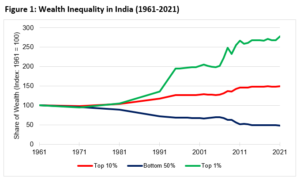 Wealth Concentration
Wealth Concentration
- India’s richest 1% holds 40% of the wealth; inequality rising since the 2000s. (Oxfam 2023)
- Top 10% Wealth Holders: The wealthiest 10% of India’s population controls around 77% of the country’s total wealth. This highlights a high level of wealth concentration among the top earners.
- The Richest 1%: Around 73% of the wealth generated in recent years has been absorbed by the wealthiest 1%, further exacerbating the wealth gap.
Income Inequality
Income inequality in India refers to the unequal distribution of income among individuals and groups within the country. Despite significant economic growth in recent years, income inequality remains a pressing challenge in India, with large disparities between different regions, social groups and urban-rural areas.
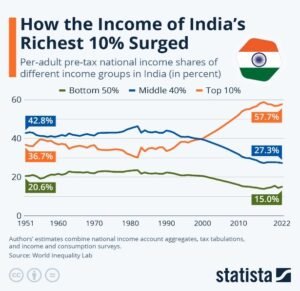 Rich-Poor Divide: According to the World Inequality Report 2022, the top 10% of India’s population holds around 57% of the national income, while the bottom 50% receives only 13%.
Rich-Poor Divide: According to the World Inequality Report 2022, the top 10% of India’s population holds around 57% of the national income, while the bottom 50% receives only 13%.- Urban-Rural Divide: Urban areas have higher incomes compared to rural areas, which are mostly dependent on agriculture.
- Social Group Inequality: Marginalized groups, like Scheduled Castes, Scheduled Tribes and women, face lower income levels.
- Regional Disparities: Wealth concentration is higher in certain states, with some lagging behind in economic development.
- Informal Sector: A large informal workforce often receives lower wages, contributing to inequality.
- Education & Skill Gaps: Income disparity is tied to educational and skill levels, with highly educated individuals earning significantly more.
| Lorenz Curve and Gini coefficient |
|
Gini Coefficient = A/A+BThe Gini coefficient ranges from 0 to 1: 0 represents perfect equality, where everyone has the same income or wealth.1 represents perfect inequality, where all income or wealth is held by one individual or household and everyone else has none. |
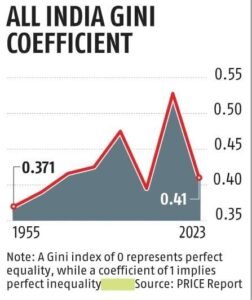 Income Inequality in India:
Income Inequality in India:
India’s Gini coefficient ranges between 0.35 to 0.40, indicating a relatively high level of income disparity compared to other nations.
It has generally increased over the years, as shown in the chart given here.
Consequences of Inequality
- Perpetuation of the Middle-Income Trap: Inequality limits broad-based development, preventing sustained growth needed to become a high-income economy.
- Social Unrest: Frustration from inequality fuels instability and diverts focus from necessary economic reforms.
- Weak Workforce Development: Unequal access to education and healthcare creates a less skilled labour force, limiting high-value sector growth.
- Economic Inefficiency: Concentrated wealth hinders resource distribution, reducing economic diversification and growth potential.
- Diminished Domestic Demand: Low purchasing power among the majority weakens consumer markets, delaying transitions to advanced industries.
- Stifled Innovation: Unequal access to resources and opportunities suppresses innovation, preventing progress in high-value sectors.
- Creation of Different India: Inequality fragments society into India 1 (developed), India 2 (aspirational) and India 3 (underdeveloped).
Inequality leads to the creation of different types of India.
| People often create a distinction between India and Bharat, in which India represents the educated high class which has better access to the government and Bharat represents the section of the society that is not connected because of the “English” illiteracy. |
The Businesses have started classifying India into —India 1, India 2, and India 3—describing the socio-economic inequalities and the stark contrast in living standards among different sections of the Indian population. This framework highlights the disparity in access to resources and therefore allows the businesses to focus well on the community that has a greater spending power, i.e. India 1.
India 1:
Represents urban, affluent and technologically advanced India. It is characterized by:
- A small percentage of the population (typically the top 5–10%).
- High-income groups living in metropolitan areas.
- Access to world-class infrastructure, education, healthcare and digital technology.
- Engaged in knowledge-based industries such as IT, finance and multinational corporations.
Challenges: Even though India 1 is highly developed, it often remains disconnected from the realities of rural and less-privileged populations.
India 2:
It represents the semi-urban and lower-middle-class India, living in smaller towns or Tier 2 and Tier 3 cities. It is characterized by:
- A significant proportion of the population (estimated at 30–40%).
- Transitional economy — people moving from agriculture to industry or services.
- Moderate access to basic amenities and digital technology.
- Working in sectors like manufacturing, small businesses, or public services.
Challenges: India 2 faces difficulties in accessing high-quality healthcare, education and stable job markets. Many people in this group struggle to achieve upward mobility.
India 3:
It represents rural, impoverished, and marginalized India and is characterized by:
- A large portion of the population (over 50% in rural areas).
- Primarily engaged in agriculture and informal labour.
- Limited access to education, healthcare, electricity, and technology.
- Vulnerable to poverty, malnutrition, and lack of social security.
Challenges: This group struggles with systemic poverty, poor infrastructure and limited government support, contributing to a cycle of inequality.
Solutions to Address Inequality and bridging the divide
- Progressive Taxation: A more progressive tax system, where the wealthy pay higher taxes, can help redistribute wealth and reduce income inequality.
- Social Security Programs: Expanding welfare programs like universal healthcare, pensions, and unemployment benefits to support lower-income groups and reduce economic disparities.
- Inclusive Economic Growth: Policies that promote equitable growth across sectors, including rural development, small businesses, and opportunities for marginalized communities.
- Access to Quality Education: Investing in education and skill development for disadvantaged groups to bridge the educational gap and enhance social mobility.
- Improved Healthcare Access: Ensuring universal access to healthcare, especially for the poor, to reduce health disparities and improve overall well-being.
- Land and Asset Reforms: Policies to promote more equitable distribution of land and assets, particularly in rural areas, to empower low-income and marginalized populations.
Middle-Income Trap
The middle-income trap occurs when a country’s economy stagnates after reaching middle-income levels ($1,046 to $12,535 per capita), preventing it from advancing to high-income status. Thus, they find it hard to progress beyond a certain income level.
Countries in this trap experience slow economic growth and rising inequality, with wealth concentrated among a small elite. It is characterised by the following:
- Stagnation at Middle-Income Levels: Growth slows after reaching middle-income thresholds.
- Dependence on Low-Wage Labor: Over-reliance on labour-intensive industries hampers growth.
- Challenges in Innovation and Productivity: Lack of investment in education, technology, and infrastructure stifles innovation.
- Inequality: Rising disparities limit social mobility.
For Example, Countries like Brazil, Malaysia and Thailand have faced challenges in moving beyond middle-income status due to political instability, low innovation and reliance on natural resources.
However, China has narrowly escaped this trap successfully (with a per capita income of $13,873.31 in 2025) and is certain to be counted as a high-income country in a few years. To escape, individuals need to focus on improving education, gaining new skills and seeking out better opportunities in more lucrative sectors.
Why is Middle Income Trap a TRAP?
It is considered a “trap” because countries find it difficult to advance beyond a certain level of development due to a combination of structural challenges, economic limitations and institutional weaknesses given below.
- Inability to Transition to High-Value Industries: Without sufficient investment in education, research and infrastructure, middle-income countries struggle to move into advanced sectors like technology and innovation.
- Exhaustion of Initial Growth Drivers: Countries reach a point where low-cost labour, resource extraction, or basic manufacturing can no longer sustain economic growth, limiting progress.
- Vulnerability to External Shocks: Economic crises, recessions, or global disruptions can severely affect middle-income countries, causing setbacks and making it harder to reach high-income status.
- Stagnant Productivity Growth: As wages rise, middle-income countries face higher labour costs but often fail to achieve corresponding productivity gains, hindering competitiveness.
- Income Inequality: Economic growth often benefits only a small portion of the population, leaving others behind. This inequality can slow social mobility and economic advancement.
- Weak Institutions and Governance: Poor governance, corruption and inefficient public services prevent the implementation of necessary reforms and hinder economic development.
- Global Competition: Middle-income countries face increasing competition from both emerging economies and advanced nations, making it harder to differentiate themselves and maintain growth.
Without addressing these structural challenges—such as improving education, enhancing productivity, fostering innovation and building strong institutions—countries remain stuck at middle-income levels, unable to make the leap to high-income status.
Rural-Urban Divide
It refers to the disparities between rural and urban areas in terms of economic opportunities, access to services, and quality of life. This divide is shown in the following ways:
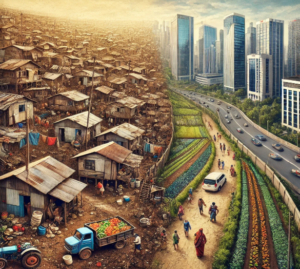 Economic Opportunities: Urban areas offer more diverse and higher-paying jobs, while rural areas often rely on agriculture and small-scale industries with fewer opportunities and lower wages.
Economic Opportunities: Urban areas offer more diverse and higher-paying jobs, while rural areas often rely on agriculture and small-scale industries with fewer opportunities and lower wages.- Education: Urban areas have better educational infrastructure, leading to higher educational attainment and better job prospects, while rural areas often face underfunded schools and lower educational outcomes.
- Healthcare: Urban areas have better healthcare facilities and access to medical services, while rural areas face limited healthcare options, resulting in poorer health outcomes.
- Infrastructure: Urban areas enjoy better transportation, utilities and internet access, whereas rural areas often struggle with inadequate infrastructure, limiting access to essential services.
- Digital Divide: Urban residents have better access to technology and the internet, while rural populations face limited connectivity, hindering opportunities for education and economic advancement.
- Migration: Rural-to-urban migration often occurs due to better opportunities in cities, leading to overcrowding and pressure on urban resources, while rural areas may experience a “brain drain.”
Addressing the rural-urban divide requires policies that improve infrastructure, education, healthcare and economic opportunities in rural areas to promote equality and social inclusion.
Environmental Vulnerability Due to Poverty
Poverty significantly exacerbates environmental vulnerability, making poor communities more susceptible to the negative effects of environmental hazards, climate change and environmental degradation. Here’s how poverty contributes to environmental vulnerability:
- Living in Hazard-Prone Areas: Poor communities often settle in unsafe areas, like floodplains or near toxic waste, due to affordability, increasing their exposure to natural disasters.
- Lack of Infrastructure: Poor infrastructure, including inadequate housing, sanitation and drainage, worsens the impact of floods and disease outbreaks.
- Limited Disaster Preparedness: Lack of resources and access to disaster response systems leaves these communities ill-prepared for hazards like floods and heatwaves.
- Poor Health and Nutrition: Poor health due to inadequate nutrition and healthcare makes it harder for individuals to cope with environmental stressors.
- Limited Access to Education: A lack of education reduces awareness of environmental risks, leaving communities unprepared to mitigate or adapt to environmental changes.
- Depletion of Natural Resources: Dependence on local resources for survival can lead to over-exploitation, causing environmental degradation and further harming livelihoods.
Vulnerability to Climate Change: Climate change disproportionately impacts the poor, leading to displacement, food insecurity and loss of livelihoods, particularly
Related FAQs of Poverty and Human Development
Poverty limits access to education, healthcare, and basic services, which directly impacts human development. It reduces economic mobility and leads to long-term deprivation and inequality.
Key issues include inequality, rural-urban divide, environmental vulnerability, and social exclusion. These challenges limit inclusive growth and sustainable development in India.
Inequality is measured using tools like the Gini coefficient and Lorenz Curve. India’s Gini coefficient (around 0.35–0.40) indicates significant income disparity. The richest 1% hold over 40% of the nation’s wealth.
The middle-income trap is when a country’s growth stagnates after reaching a certain income level. It’s a concern for India as inequality, low innovation, and skill gaps could hinder progress to a high-income economy.
Bridging the rural-urban divide requires investment in rural infrastructure, healthcare, digital access, education, and job creation to ensure equal opportunities and social inclusion.

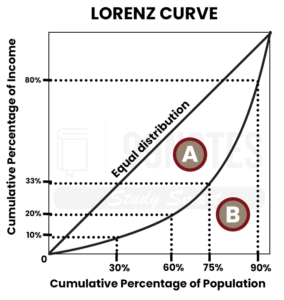 It acts as a measure of income inequality within a country or a population. Calculation: The Gini coefficient is calculated based on the Lorenz curve, which shows the cumulative distribution of income or wealth against the population.
It acts as a measure of income inequality within a country or a population. Calculation: The Gini coefficient is calculated based on the Lorenz curve, which shows the cumulative distribution of income or wealth against the population.

![Home Rule Movement (1916-1918): India'S Fight For Self-Governance [Upsc Notes] | Updated April 10, 2025 Home Rule Movement (1916-1918): India’S Fight For Self-Governance [Upsc Notes]](https://www.99notes.in/wp-content/uploads/2024/02/home-rule-featured-66698a5b2a805-768x500.webp)
